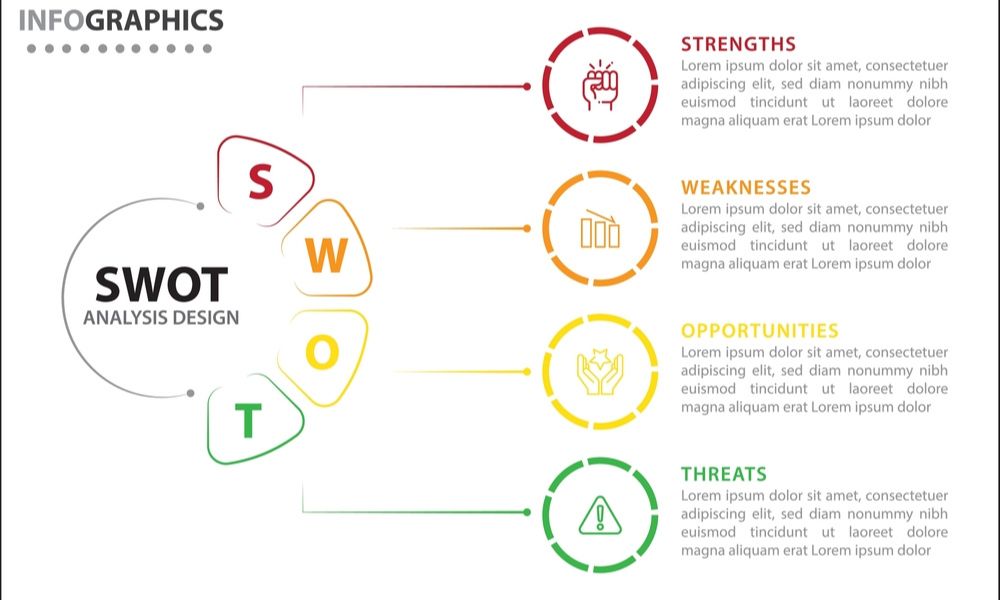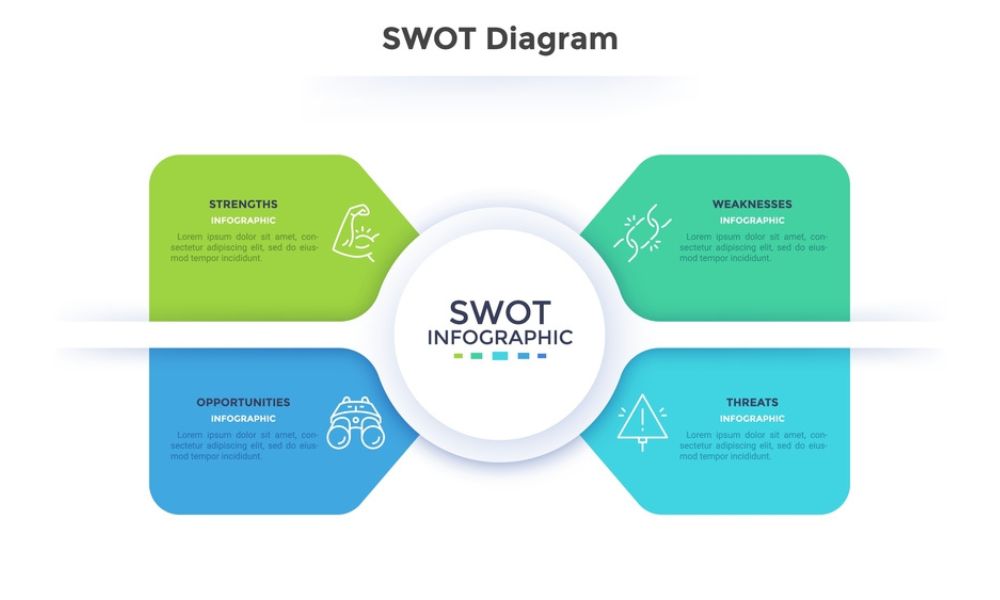In the dynamic world of the construction industry, every decision counts, and every strategy matters. As a construction company, understanding your position in the market and identifying the opportunities and threats that surround you is essential for long-term success. This is where the SWOT analysis comes in—an invaluable tool that can provide clarity and direction for any construction business.
Whether you are planning to grow your business, diversify into new markets, or enhance your operations, conducting a thorough SWOT analysis can help you make informed, strategic decisions. This framework is easy to understand and offers significant value to construction businesses by identifying internal strengths, weaknesses, external opportunities, and threats. In this article, I will guide you through the SWOT analysis and show you how to apply it effectively in your construction company.
Key Topics You Will Learn:
- What is SWOT Analysis?
- Why is SWOT Analysis Important for Construction Companies?
- How to Conduct a SWOT Analysis for Your Construction Business
- Examples of SWOT in Construction Industry
- How to Use SWOT Analysis for Strategic Growth
Let’s dive right into the details of SWOT analysis and explore how it can empower your construction business to grow and succeed in an ever-competitive market.
What is SWOT Analysis?
SWOT analysis is a strategic tool used to understand the internal and external factors that can influence the success of your business. The acronym stands for:
- Strengths – The internal characteristics or advantages of your construction company that help it succeed.
- Weaknesses – Internal factors that can hinder the performance of your business.
- Opportunities – External factors that your construction business can exploit for growth and success.
- Threats – External challenges or risks that could harm your business or limit its potential.
By analyzing these four aspects, a construction company can build a solid foundation for strategic planning and ensure that it stays competitive in the industry.

Why is SWOT Analysis Important for Construction Companies?
In construction, understanding your company’s position in relation to your competitors, your customers, and the broader market environment is crucial. Whether you are bidding for a major construction project or managing an ongoing construction venture, knowing your strengths and weaknesses will provide clarity on how to approach each situation.
Here’s why conducting a SWOT analysis is important for construction companies:
Identifies Strategic Goals:
SWOT analysis helps you identify the key areas of your business that need improvement and the opportunities available for growth. This information is crucial in setting realistic business goals.
Supports Decision Making:
By having a clearer understanding of external opportunities and threats, along with internal strengths and weaknesses, you can make more informed and confident decisions about the direction of your company.
Improves Resource Allocation:
A good SWOT analysis can help you allocate resources more efficiently. If you identify a weakness or threat that could jeopardize a project, you can take steps to mitigate it, such as improving your operations or diversifying your service offerings.
Increases Market Competitiveness:
Knowing your strengths allows you to leverage them in the marketplace. Similarly, understanding your weaknesses allows you to work on them, making your company more competitive in the long run.
How to Conduct a SWOT Analysis for Your Construction Business
Conducting a SWOT analysis for your construction business involves examining both your internal resources and external market conditions. Here’s a step-by-step approach to perform a SWOT analysis:
1. Examine External Factors (Opportunities & Threats)
Start by analyzing the external environment to identify the opportunities and threats that might impact your business. External factors include anything outside of your company’s direct control. Here’s what to consider:
Opportunities:
These can include new construction projects, government contracts, market growth, technological advancements, and changing industry regulations that you can capitalize on. For example, if there’s a boom in infrastructure projects in your region, this could represent an opportunity for your business to expand.
Threats:
This category includes economic downturns, changes in government policies, increasing competition, or any other external force that might negatively impact your business. For example, rising material costs or labor shortages can present significant threats to your profitability.
2. Examine Internal Factors (Strengths & Weaknesses)
Next, turn your attention inward and assess your company’s internal strengths and weaknesses. This could involve evaluating your resources, capabilities, and processes. Here’s what to look for:
Strengths:
Identify what your business does well. This could be a strong brand reputation, a well-established network of suppliers and subcontractors, highly skilled workers, or innovative construction techniques that set you apart from the competition. These strengths are the pillars that support your business and should be leveraged to achieve success.
Weaknesses:
Assess areas where your business could improve. This might include outdated equipment, limited financial resources, a lack of project management expertise, or a small customer base. Recognizing weaknesses will allow you to address them before they become a significant barrier to growth.
3. Analyze and Interpret Results
Once you’ve identified your opportunities, threats, strengths, and weaknesses, the next step is to analyze how they interact with each other. Consider questions such as:
- How can you leverage your strengths to seize new opportunities?
- Are there weaknesses that prevent you from capitalizing on opportunities?
- How can you mitigate the threats in the external environment?
- What do you need to improve internally to stay competitive?
By answering these questions, you will be able to identify strategic priorities for your construction business.
Examples of SWOT in the Construction Industry
Let’s take a look at some specific examples of how SWOT analysis might be applied to a construction company:
Strengths:
A construction company with a strong reputation for quality craftsmanship and a network of reliable suppliers may use this strength to attract high-profile clients or secure long-term contracts.
Weaknesses:
A company that lacks modern construction equipment may face delays or increased costs, affecting their ability to stay competitive.
Opportunities:
A government initiative to invest in public infrastructure could provide a construction company with lucrative contracts in roads, bridges, and schools.
Threats:
A sudden increase in material prices or changes in zoning laws could create financial pressures or project delays, affecting the overall success of a construction company.
How to Use SWOT Analysis for Strategic Growth
Once you have completed your SWOT analysis, you can use the results to guide your strategic growth. Here are some ways to apply SWOT findings:
Leverage Strengths for Competitive Advantage:
If your company’s strength is its skilled workforce, you might consider expanding your business into high-end residential or commercial projects where top-tier craftsmanship is highly valued.
Mitigate Weaknesses by Building on Them:
If your company lacks the financial resources to compete on larger projects, consider seeking partnerships with other companies, applying for government grants, or securing lines of credit to strengthen your financial position.
Capitalize on Opportunities:
If there is a demand for green building practices in your region, consider developing expertise in sustainable construction methods to meet market demand and attract environmentally conscious clients.
Develop Threat-Response Plans:
If economic downturns are a threat to your business, prepare by diversifying your service offerings or finding ways to reduce operational costs without sacrificing quality.

Conclusion
SWOT analysis is a powerful tool that can help construction companies make informed, strategic decisions. By thoroughly understanding your strengths, weaknesses, opportunities, and threats, you can take proactive steps to grow your business, manage risks, and stay ahead of the competition.
As you conduct your own SWOT analysis, keep in mind that it’s not just about identifying problems or challenges. It’s about creating actionable strategies that will help your company thrive in the construction industry. Whether you are a small business or a large enterprise, SWOT analysis provides you with the clarity and insight necessary to make confident decisions.
Get in touch with us today for a free sample of our branding and design services, and start building your construction company’s path to success!


